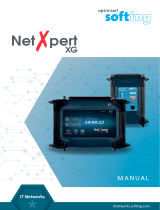UNI-T UT685B, UT685B Kit User manual
- Category
- Cable network testers
- Type
- User manual
This manual is also suitable for
UNI-T UNI-T UT685B, UT685B Kit is a handheld TDR cable tester, suitable for copper cables (CAT 5E、CAT 6、CAT 6A or CAT 8), used to detect and diagnose wiring condition of twisted pair and coaxial cable, detect network service, short/open circuit in network cabling, split pair, miswire, etc. It can also be applied to detect if there is PoE supply (POE module) in network cabling and PoE standard (802.3AF, 802.3AT, 802.3BT). Wiremap, cable length, open-circuit location and other information can be displayed on the screen simultaneously.
UNI-T UNI-T UT685B, UT685B Kit is a handheld TDR cable tester, suitable for copper cables (CAT 5E、CAT 6、CAT 6A or CAT 8), used to detect and diagnose wiring condition of twisted pair and coaxial cable, detect network service, short/open circuit in network cabling, split pair, miswire, etc. It can also be applied to detect if there is PoE supply (POE module) in network cabling and PoE standard (802.3AF, 802.3AT, 802.3BT). Wiremap, cable length, open-circuit location and other information can be displayed on the screen simultaneously.










-
 1
1
-
 2
2
-
 3
3
-
 4
4
-
 5
5
-
 6
6
-
 7
7
-
 8
8
-
 9
9
-
 10
10
UNI-T UT685B, UT685B Kit User manual
- Category
- Cable network testers
- Type
- User manual
- This manual is also suitable for
UNI-T UNI-T UT685B, UT685B Kit is a handheld TDR cable tester, suitable for copper cables (CAT 5E、CAT 6、CAT 6A or CAT 8), used to detect and diagnose wiring condition of twisted pair and coaxial cable, detect network service, short/open circuit in network cabling, split pair, miswire, etc. It can also be applied to detect if there is PoE supply (POE module) in network cabling and PoE standard (802.3AF, 802.3AT, 802.3BT). Wiremap, cable length, open-circuit location and other information can be displayed on the screen simultaneously.
Ask a question and I''ll find the answer in the document
Finding information in a document is now easier with AI
Other documents
-
Triplett LVPRO10 User manual
-
Fluke Networks MicroScanner™ PoE Industrial Ethernet Cable Verifier User manual
-
CAS NC-500 User manual
-
Ideal Networks SignalTEK NT User manual
-
Fluke DTX-GFM2 Technical Reference Handbook
-
Fluke DTX-ELT Technical Reference Handbook
-
 Reely NetXpert XG User manual
Reely NetXpert XG User manual
-
Agilent Technologies N2610A User manual
-
IDEAL INDUSTRIES NaviTEK II User manual
-
Fluke Network Tester User manual










